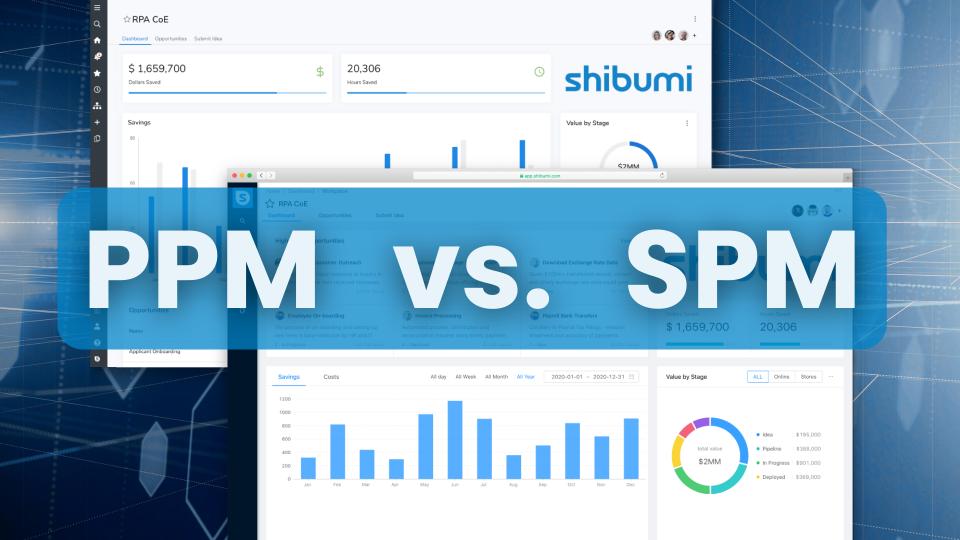All project managers know the success of any project depends on a few key elements — including planning, organization, and execution. Good project managers know to start the project planning process with the project’s end goal in mind. They focus on finding the optimal budget, resources, and sequence milestones to accomplish the project’s strategic goals.
This collection of activities conducted by outstanding project managers, including careful project planning, milestone setting, and close monitoring of resource utilization and budget burndown, is a discipline known as project portfolio management (PPM).
Yet, even when an organization has strong PPM discipline, it may fail to achieve desired business outcomes around improving profitability, customer satisfaction, and growth. There is often a disconnect in organizations between high-level strategy and detailed project execution. That’s where strategic portfolio management (SPM) comes into play; it’s an operational discipline that helps organizations close the strategy-to-execution gap and achieve their most strategic business outcomes.
While strategic portfolio management (SPM) and project portfolio management (PPM) serve different purposes, they also share common principles.
In this article, we’ll shed light on how the SPM and PPM differ in their purpose and when to utilize SPM versus PPM for the benefit of your organization. Hint: They are complementary approaches, each with its own merits.
What is Project Portfolio Management?
Put simply, PPM is an approach utilized by project managers within an organization to plan and execute projects that decision-makers have identified and chosen to fund. Projects that fit under the same theme, focus area, or value pillar or utilize the same set of resources are managed under one portfolio, which ensures that resources are allocated and managed appropriately.

PPM involves project intake, which requires identifying all potential projects, signing off on them, designating project managers, and including them in the project portfolio. Finally, PPM involves careful control and monitoring to ensure all current projects are executed efficiently and on budget.
According to Gartner analysts, a leading practice for PPM is to “enhance the collaboration, communication, and resulting project portfolio-level reporting needed to gain first-line visibility into project demand, project status, resource capability, and utilization, and cost estimates vs. actuals.” Gartner recommends that PPM leaders look first to understand “what are the project demands?”, “what resources do we have?”, and “what are the dependencies between projects?” before jumping into planning individual projects.
By incorporating more contextual information into the project planning process, PPM leaders and project managers will set more realistic expectations for a project’s value and make more informed decisions around budget allocation, timeline, staff assignments, etc. They can better anticipate potential delays, ward off resource conflicts, and increase the odds that projects deliver the expected benefits.
Further, Gartner says successful PPM is characterized by “the ongoing development and refinement of methods and practices and ensuring that any software tools deployed meet the needs without becoming a burden.” In other words, PPM should be adaptive to what’s worked and what you know about your organization.
Why is PPM Important?
PPM is crucial in ensuring that projects are well-resourced, well-coordinated, executed efficiently (on time and budget), meet the expected business outcomes, and realize value.
What is Strategic Portfolio Management?
Strategic portfolio management (SPM) is a discipline and operating approach that helps organizations achieve their desired business outcomes. It focuses on the vital alignment of investments (including projects, headcounts, IT systems, and digital products) to strategy; it puts high importance on tracking the outcomes and value of projects and emphasizes the value of agility and adaptability.
An organization that takes an SPM approach will often say things like this:
- “We need to be more intentional where we invest our talent to maximize value, deliver on our objectives, and progress our strategy.”
- We want to use fair and accurate comparisons when making choices.
- We want to prioritize projects and initiatives at a higher level than what is happening today.
- We want to use data to justify when we should say “No” to something new or “Stop” something we’re currently doing.
- It’s important to use benefits and costs when making each investment choice.
- We want to look at our work in aggregate. As a whole, does this set of investments help us achieve what we’re looking to achieve?
Above all else, doing SPM well requires organizations to take their time to ensure alignment between projects and strategy and prioritize projects based on their potential to deliver benefits or value to the organization.
Why is SPM Important?
Many companies are starting to recognize the value of SPM as they face increasing demand to transform their business and do more with less. Shibumi’s 2024 Strategic Portfolio Management Benchmark Survey found that 70% of for-profit organizations with more than 1,000 employees are undergoing one or more transformation initiatives this year. 83% of the survey respondents said their organization is undergoing three or more types of transformations concurrently (e.g., AI, digital, supply chain, sustainability, cost, workforce, health and wellness, M&A, etc.).
SPM is an approach that can help organizations improve corporate performance and increase the odds that their transformation initiatives will succeed. While it feels natural for ambitious executives to push their organizations to do more and more, SPM provides a much-needed framework for large, complex organizations to remove noise, improve focus, simplify execution, and optimize resource usage across the enterprise.
When organizations take these operating principles to heart, they are more likely to achieve their desired business outcomes and reach their destination with less friction and happier employees.
In short, the key benefits of SPM include:
- Better alignment of initiatives and projects with overarching business goals
- More optimal allocation of company resources
- Faster decision-making cycles
- Improved risk management of in-flight initiatives and projects
- Better project outcomes and, more importantly, business value delivered from the portfolio
How to Embed SPM Principles into an Organization
The benefits of SPM can bring a lot of good to organizations, so how do businesses get started?
Based on Shibumi’s experience working with clients building SPM capabilities, here are the key steps we recommend to portfolio management and project managers:
1. Improve Visibility into Organizational Goals, Priorities, and Resources
SPM will not take hold and stick unless senior executives understand its benefits and become sponsors of the approach. An organization’s senior leaders should set clear priorities for the business and provide department leaders and mid-level managers visibility to business goals, key priorities, and the company’s criteria to decide which projects are worth doing and what gets investment.
Creating clarity and upfront visibility are vital steps in helping your organization sharpen its focus. Having clarity and big-picture context encourages leaders to invest in fewer, higher-value projects/initiatives that can receive adequate resources vs. “peanut-buttering” resources across many projects. It helps an organization identify what those few big-rock (cross-functional) initiatives should be. It makes it easier for people to hear and accept that their “pet” projects will not receive funding (because they aren’t aimed at advancing key business priorities).
2. Put Investment Governance Guardrails in Place
Many organizations allow individual department leaders (VPs and Directors) to make decisions independently (hiring, technology purchase, projects to fund); each department uses different decision-making processes, project management methodologies, and business case and reporting templates. While this decentralized approach has merits, it also creates issues such as budget overruns, under-funded projects, and a lack of cross-functional coordination, leading to project completion delays – ultimately undermining corporate performance.
To curb these issues, savvy organizations are putting investment guardrails in place to mitigate the risk of making wrong, costly decisions. Practical guardrails to consider include:
- Forecasting project demands and new project proposals in batches – only during designated times of the year (rather than one at a time).
- Asking everyone to answer a standard set of business case questions when submitting a project proposal.
- Asking people to be more conservative and factual in their estimates (e.g., a project’s benefits, resource requirements, timelines).
- Let everyone know that decision-makers will only consider project ideas with detailed business cases and resource plans.
- “Penciling in” the “big-rock” cross-functional projects first before greenlighting additional smaller projects.
- Setting stage gates for projects and inserting people to review work done in the previous step before a project is allowed to proceed to the next stage.
3. Organize Strategic Portfolio Management Review Meetings
Organize regularly cadenced meetings for organizational leaders to stay aligned on priorities, check in on the progress of critical projects, trouble-shoot together if any key projects are veering off-track, update one another on any shifts in priorities or strategies, and review the outcomes of completed projects against targets or expectations. Further, if the group decides that priorities need to shift, promptly communicate those changes to lower levels of the organization to employees closest to the work.
4. Improve Agility by Investing in Data Capabilities
In today’s dynamic business environment, the ability to adjust courses quickly is imperative to a company’s survival. Agile companies incorporate competitive changes, macroeconomic, industry-specific shifts, and feedback from Boards and investors into their company strategy and make execution adjustments based on feedback. However, many organizations struggle to access timely data needed for pivots.
To enable agility, leaders should focus on:
- Streamlining internal processes for rapid response to shifts.
- Establishing early warning systems with real-time data (which requires setting up automation).
- Using scenario planning and simulations to stress-test strategies.
- Building skills and doing culture-shifting work teaching people to embrace change vs. rigidity.
What’s the Difference Between PPM and SPM?
At first glance, PPM and SPM seem very similar. Both involve managing project portfolios and driving business goals forward; however, the focus of each approach is different.

Simply put, the differences between PPM and SPM can be summarized as follows: PPM drives projects forward; SPM drives strategy.
PPM keeps teams focused on project execution, while SPM keeps projects aligned with strategic business goals. Utilizing both ensures that projects are doable and contribute to business success now and in the future.
PPM or SPM: Which Does My Business Need?
Your organization will likely benefit from adopting both complementary approaches. SPM is needed to select suitable projects; once those are chosen, PPM ensures that projects are done efficiently, on time, and budget.
PPM is a beneficial approach for all but the smallest organizations. After all, virtually all organizations manage multiple projects simultaneously and have concerns about specific projects.
If your organization is relatively small and top-down decision-making is the norm, you may wait to add formal governance processes and investment/decision-making criteria. However, even small organizations can benefit from implementing certain pieces of SPM. For instance, if your firm needs to achieve a more ambitious revenue growth goal this year but your budget hasn’t increased year over year, rationalizing investments (deciding what you will not do) will help you make the most of existing resources.
Suppose your organization is already operating at some scale (e.g., in multiple regions, selling numerous products, operating several business units), or you expect to experience rapid growth shortly. In that case, it is time to introduce SPM to your organization to help leaders get better visibility into the portfolios and make value-based investment decisions.
If your business has decided to undergo some transformation and you want to increase its odds of succeeding, SPM will be a vital tool for a smoother journey.
Suppose you are already a large, complex organization and find current portfolio management processes inconsistent or projects often don’t deliver the expected ROI. In that case, it’s time to prioritize standing up an SPM function.
Learn more
Want to build a successful SPM office in your organization? Consider working with Shibumi, the leading Strategic Portfolio Management Software platform on the market. We’ll provide the methodology, expertise, and best practices to make the right decision.
To see how Shibumi can help, request a demo today.

